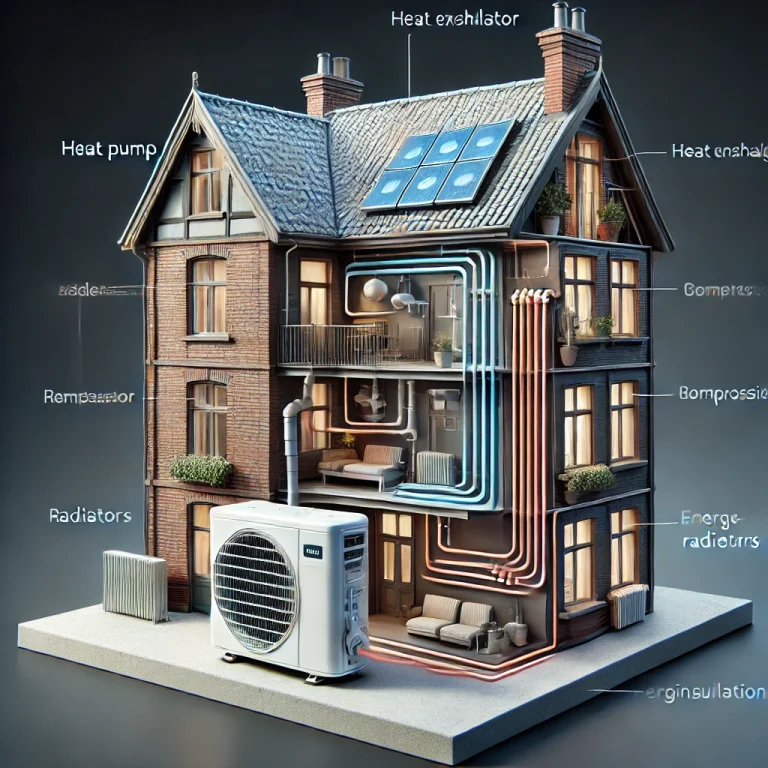🏢 Heat Pumps in Old Buildings: Are They Worth It? A Complete Guide

✨ The Future of Heating: Can Heat Pumps Work in Old Buildings?
As the world moves towards sustainable energy solutions, heat pumps are gaining popularity as an efficient and environmentally friendly alternative to traditional heating systems. But do they work in old buildings, or are extensive renovations required? Let’s explore how heat pumps can be used effectively in aging structures.
✅ Can Heat Pumps Be Installed in Old Buildings?
One of the most common concerns about heat pumps is whether they can produce sufficient flow temperatures to heat older buildings with radiators and limited insulation. According to research from the Fraunhofer Institute for Solar Energy Systems (ISE), the answer is a clear yes!
▶️ Modern heat pumps can reach flow temperatures of 60-70°C, making them compatible with older heating systems. High-performance models using propane or advanced compressors can easily meet the heating demands of most old buildings.
▶️ Heat pumps remain efficient even in cold temperatures, with tests showing a coefficient of performance (COP) of 2.3 at an outside temperature of -3.6°C.
⚡ Heat Pump Benefits for Old Buildings
🏠 Improved Comfort – Even temperature distribution and reduced energy waste.
📈 Lower Energy Bills – Despite higher upfront costs, savings on heating bills make heat pumps a cost-effective solution.
💨 Reduced Carbon Emissions – Heat pumps work with renewable energy, significantly lowering CO2 emissions.
🔄 Flexible Installation – Can be installed in various configurations, including air-source, ground-source, or hybrid systems.
🔧 Compatible with Existing Radiators – No need for full heating system replacement; existing radiators can be optimized.
🛠️ Do Heat Pumps Require Renovation?
Some homeowners worry that major insulation and renovation work is necessary before installing a heat pump. While better insulation improves efficiency, heat pumps can still operate effectively in unrenovated buildings.
▶️ If your home has a heating demand below 150 kWh/m², a heat pump can provide sufficient warmth without extra modifications.
▶️ If the demand is higher, small upgrades like window replacements, wall insulation, or larger radiators can further optimize efficiency.
⚖️ Heat Pumps vs. Gas Heating: Which is More Cost-Effective?
While heat pumps have higher installation costs, they provide long-term savings. With gas prices fluctuating, heat pumps are often cheaper to operate, even with the current electricity grid mix.
▶️ Studies show that heating costs with a heat pump are already lower than gas heating in most cases.
▶️ Future energy policies and incentives are expected to make heat pumps even more attractive financially.
📊 Case Studies: Heat Pumps in Old Buildings
Fraunhofer ISE conducted field studies to test heat pumps in aging structures. Here’s what they found:
🏡 Case 1: 84-Year-Old House
Very poor energy condition (210 kWh/m²a heating demand)
Installed air-source heat pump & replaced radiators
Achieved efficiency (COP) of 3.0, requiring almost no electric heating backup
🏢 Case 2: 48-Year-Old House
Better insulation (100 kWh/m²a heating demand)
Installed ground-source heat pump with existing radiators
Achieved efficiency (COP) of 3.7, showing significant energy savings
These examples show that heat pumps work effectively even in older, unrenovated buildings, provided they are correctly sized and installed.
🌟 Key Takeaways: Should You Install a Heat Pump in an Old Building?
💡 Yes! Heat pumps are viable for most old buildings, even those with traditional radiators.
🏘️ Renovation helps but is not always necessary. Small upgrades like better insulation or larger radiators can optimize performance.
🌿 Lower emissions & energy savings make heat pumps a great long-term investment.
📈 Incentives & rebates may be available to offset installation costs.
✉ Get Expert Advice on Heat Pumps for Your Building
At AxonCad, we specialize in BIM-integrated heating solutions for both new and existing buildings. If you’re considering a heat pump system for your old building, contact us today for a customized consultation.
📞 Call us: [Your Contact Number]
📧 Email: [Your Email Address]
🌐 Visit our website: [Your Website URL]
Let’s make your building more energy-efficient and sustainable! 🌬️🏠
⚙️ Related Topics
#HeatPumps #SustainableHeating #RenewableEnergy #HomeRenovation #EnergyEfficiency #OldBuildings #SmartHeating #GreenEnergy #HeatingSolutions #AxonCad

